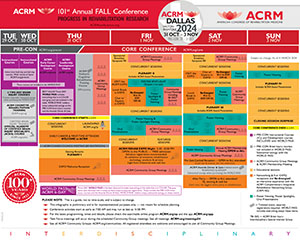Pain Rehabilitation
Rehabilitation Treatment Specification System
Clinical Outcomes of a Single Injection of BMAC in the Treatment of Symptomatic Hip Labral Tears
Saturday, November 2, 2024
3:15 PM - 3:30 PM
Location: Station 8: ROOM: POSTERLAND / Trinity Poster / Exhibit Hall REGION: Tower Lobby Level >>>
- PH
Paul Hughes, MD
MD, CEO
Hughes Orthopedics
San Mateo, California, United States 
Afroze Khan
Research Assistant
Hughes Orthopedics PC
San Mateo, California, United States
Presenting Author(s)
Research Objectives: The aim of this retrospective study was to evaluate the effectiveness of a single BMAC injection in treating the symptoms of hip labral tears, providing a nonsurgical treatment for hip labral injury.
Design: A total of 6 patients met clinical criteria (no osteoarthritis and no CAM or pincer lesions) with ten hips originally eligible for treatment. Six hips (four unilateral and one bilateral patient)
Setting: The setting of this study was outpatient orthopedic clinic in the San Francisco Bay area.
Participants: Between July 2017 and October 2019, 8 patients with symptomatic hip labral tears elected to undergo a single BMAC injection per affected hip. Patients consented to treatment and consented to be prospectively enrolled in the study.
2 patients were lost to follow-up. 1 patient underwent hip arthroscopy 12 months after injection with data prior to surgery included in analysis. A total of 5 patients all surveys at baseline and met a minimum of 12 months follow-up.
Interventions: Patients received a single injection by Bone Marrow Aspirate Concentrate (BMAC) in office. This procedure was performed using local anesthesia and with ultrasound guided hip joint injection to ensure accurate BMAC delivery. Bone marrow was harvested from the posterior superior iliac spine or iliac crest.
Main Outcome Measures: Patients completed written surveys at baseline and follow-ups, using the Visual Analogue Scale (VAS), modified Harris Hip Score (mHHS), Hip Outcomes Score Support Scale (HOS-SSS), and International Hip Outcome Tool (IHOT33).
Results: Average VAS, mHHS, HOSS-SSS, and IHOT33-Symptoms measured 8 to 2, 62 to 86, 16 to 32, and 56 to 91 respectively (p < 0.005). 4 out of 5 patients reported a satisfaction score of 8 or higher.
Conclusions: The data suggests that BMAC injection effectively reduces pain and improves hip function and hip-related symptoms in patients with hip labral tears. The favorable outcome points to this treatment being an alternative to hip arthroscopy. More extensive studies including randomized controls and longer follow up may help more definitively confirm this study’s findings further.
Author(s) Disclosures: The authors received no financial support for the research or authorship or this presentation. None of the authors declare any conflicts of interest regarding the presentation and/or publication of this research.
Design: A total of 6 patients met clinical criteria (no osteoarthritis and no CAM or pincer lesions) with ten hips originally eligible for treatment. Six hips (four unilateral and one bilateral patient)
Setting: The setting of this study was outpatient orthopedic clinic in the San Francisco Bay area.
Participants: Between July 2017 and October 2019, 8 patients with symptomatic hip labral tears elected to undergo a single BMAC injection per affected hip. Patients consented to treatment and consented to be prospectively enrolled in the study.
2 patients were lost to follow-up. 1 patient underwent hip arthroscopy 12 months after injection with data prior to surgery included in analysis. A total of 5 patients all surveys at baseline and met a minimum of 12 months follow-up.
Interventions: Patients received a single injection by Bone Marrow Aspirate Concentrate (BMAC) in office. This procedure was performed using local anesthesia and with ultrasound guided hip joint injection to ensure accurate BMAC delivery. Bone marrow was harvested from the posterior superior iliac spine or iliac crest.
Main Outcome Measures: Patients completed written surveys at baseline and follow-ups, using the Visual Analogue Scale (VAS), modified Harris Hip Score (mHHS), Hip Outcomes Score Support Scale (HOS-SSS), and International Hip Outcome Tool (IHOT33).
Results: Average VAS, mHHS, HOSS-SSS, and IHOT33-Symptoms measured 8 to 2, 62 to 86, 16 to 32, and 56 to 91 respectively (p < 0.005). 4 out of 5 patients reported a satisfaction score of 8 or higher.
Conclusions: The data suggests that BMAC injection effectively reduces pain and improves hip function and hip-related symptoms in patients with hip labral tears. The favorable outcome points to this treatment being an alternative to hip arthroscopy. More extensive studies including randomized controls and longer follow up may help more definitively confirm this study’s findings further.
Author(s) Disclosures: The authors received no financial support for the research or authorship or this presentation. None of the authors declare any conflicts of interest regarding the presentation and/or publication of this research.
Learning Objectives:
- Upon completion, participant will be able to assess whether a bone marrow aspirate concentrate procedure may be beneficial for their patients with hip labral tears.
- Upon completion, participant will be able to compare outcomes of bone marrow aspirate concentrate to established surgical options for hip labral tears.
- Upon completion, participant will be able to propose clinical studies for the application of bone marrow aspirate concentrate to similar soft tissue injuries.

.jpg)
.jpg)
.jpg)
